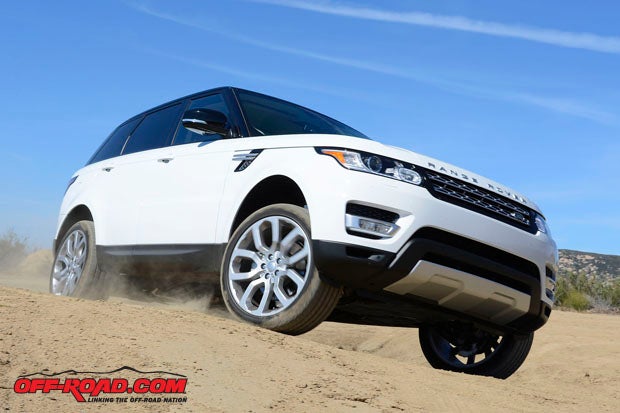
There are a number of things that can run through a person’s head while attempting a steep downhill dirt slope in an $80,000-plus vehicle. That’s the position in which we found ourselves while testing the new 2015 Range Rover Sport HSE recently. We kept nervously rattling off questions such as, Will I make this descent without tearing off a very special front end? Can 22-inch wheels with road-minded tires keep this thing from slipping off the ridge? The overarching theme of our off-road testing was probably highlighted by the thought, What the hell did I get myself into?
It ended up all those concerns were just wasted headspace. We know Range Rovers are designed to tackle off-highway terrain, but it took a little convincing that a vehicle this pretty wouldn’t get thrashed in the dirt. Fortunately for us, and our Range Rover Sport, our concerns were laid to rest.
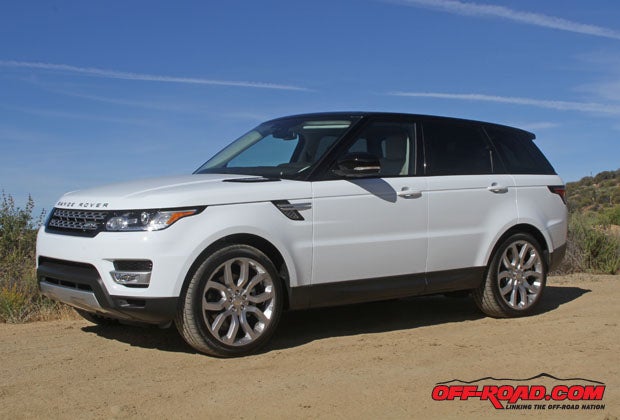
It’s been some time since we’ve hopped behind the wheel of a Range Rover. Living in Orange County in Southern California, we see plenty of these luxury SUVs roaming the Pacific Coast Highway, the 405, and sitting in the high-end driveways of SoCal’s upper crust. Range Rover is a high-end performance SUV brand nowadays, and it makes no apologies for this fact, but the U.K. manufacturer has never lost sight of its roots that harken back to the late 1940s and ‘50s, where the Land Rover was truly considered the ultimate overland vehicle. It’s possible that only a small percentage of owners will ever need its off-road capability and superior traction in a variety of terrain, but we were out to prove that these SUVs can still get dirty from time to time.
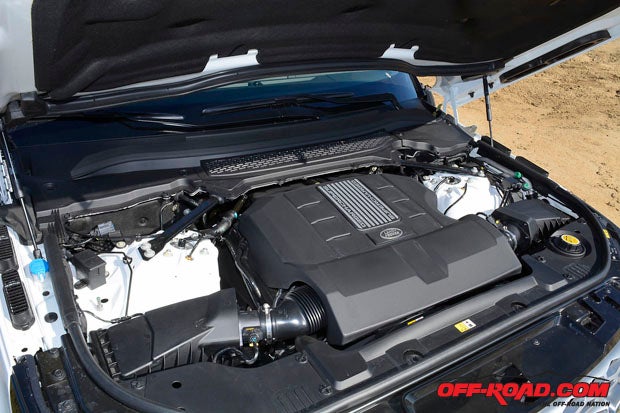
The Range Rover Sport may be a slightly less expensive entry compared to the standard Range Rover, but don’t for one second think that it’s intended to be an inexpensive, entry-level SUV. The starting price of $63,350 for the Sport SE should catch no one by surprise, as the 2015 Sport is the second generation of what the brand hails its “performance-tuned luxury SUV.” One of the biggest changes for this second-gen model that was first introduced in 2014 isn’t what the Range Rover Sport gained so much as what it lost, as it features a weight savings of roughly 800 pounds over the previous generation thanks to its high-strength aluminum frame.
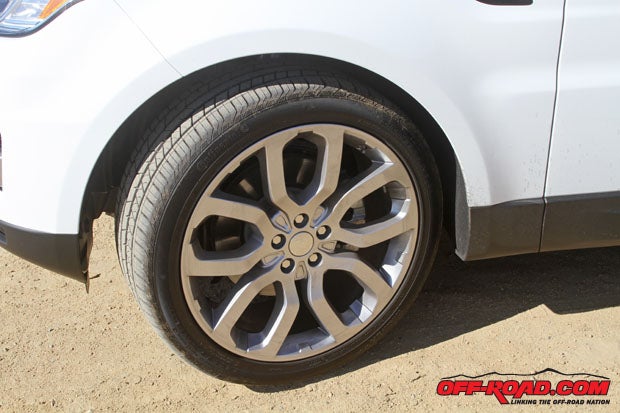
The new Range Rover Sport also measures in at 191 inches in length, which is 7 inches longer than the previous version to provide more space for backseat passengers. Although the body curves have been redesigned, of course it wouldn’t be a Range Rover without signature LED headlights, its calling card sloped grille and sleek and sculpted lines.
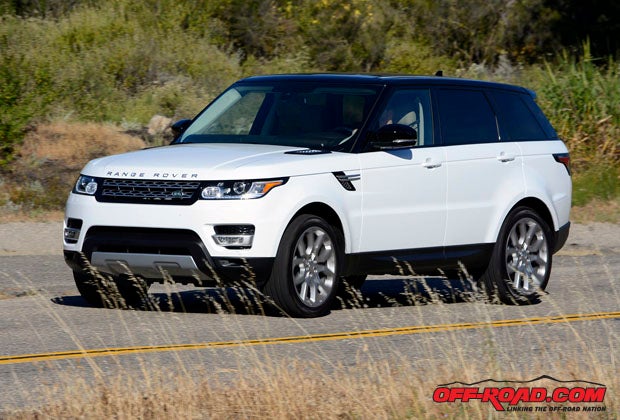
Sporting Good Show
The United Kingdom-based Range Rover brand truly caters to the sophisticated and sport-minded alike, as both performance and luxury go hand in hand with its vehicles. That in mind, the 2015 Range Rover Sport features no naturally aspirated V6 or V8 options – the Sport only features supercharged engines. For those who didn’t think a 510-hp V8 was enough, Range Rover also introduced its Sport SVR this year, and while this 550-horsepower beast is also designed with off-road capability, its $110K starting price will scare most owners away from taking it off pavement.
The supercharged 3.0-liter DOHC V6 in our test vehicle produces 340 horsepower at 6,500 rpm, and this 90-degree powerplant is based on the 5.0-liter V8 but features what Ranger Rover describes as an “innovating balance weight system to ensure exceptionally smooth and refined performance.” Range Rover says this supercharged V6 will travel from 0-60 mph in 6.9 seconds. The modern engine isn’t all brawn, however, as one of its most unique features is its Intelligent Stop/Start system that helps reduce fuel consumption during city driving.
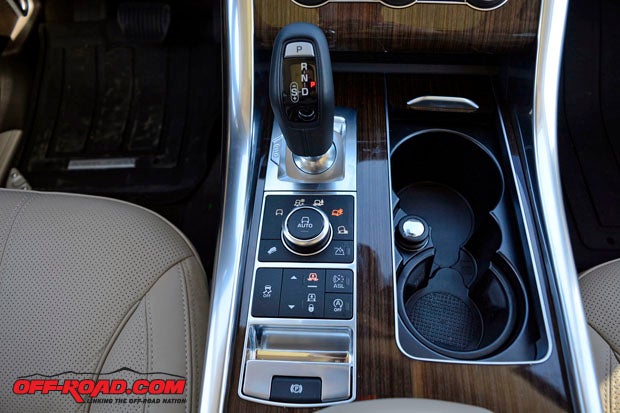
The V6 is mated to a German-made eight-speed transmission. Range Rover says its engineers designed it with closely spaced gear ratios for both efficiency and smooth operation. Our Range Rover Sport is equipped with CommandShift vertical gear shifter that includes Normal, Sport and Manual shift modes to suit the driver’s preference. The Manual mode allows the driver to take control of shifting duties, and the system does allow for multiple downshifts for engine braking or spirited driving. The company also says the eight-speed trans is tuned to quickly select torque converter lockup to reduce any slip or energy loss.
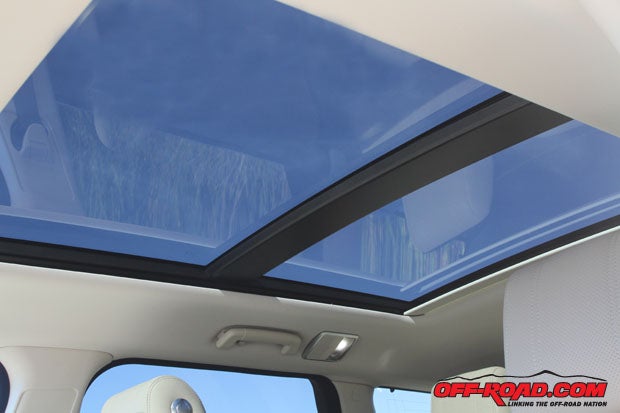
There are two transfer case options for the Range Rover Sport, but off-highway adventurers will certainly opt for the upgraded two-speed transfer case featured on our test vehicle that features low range for a lower crawl ratio. The cross-linked four-wheel air suspension found on the Sport is based on the same setup found on the standard Range Rover, though it is specifically tuned for this application. The Sport features a number of complex and unique features that aid in its off-highway performance, traction and all-around stability. One of the most unique, though only found as an option on V8 models, is the Adaptive Dynamics system that employs continuously variable magnetorheological dampers to adjust damping force based on driver input and road conditions. The magnetorheological fluid is a type of “smart fluid” that can be controlled by magnetic fields, hence allowing it to transmit enough force to control the dampers when needed.
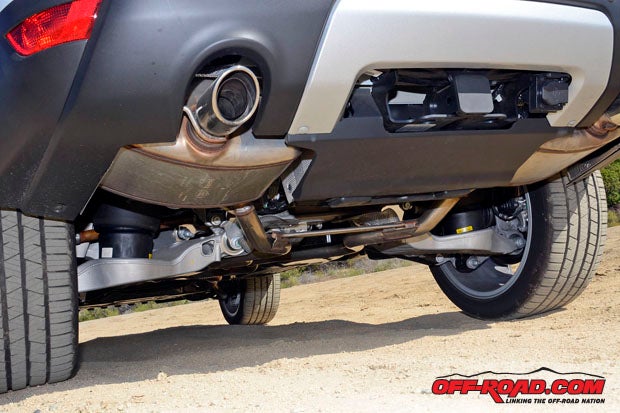
The air suspension system found on the Ranger Rover Sport has an adjustable height range of about 7 inches. It can be lowered in “access mode” for ease of entering the vehicle and raises up to its standard height with 8.4 inches of ground clearance. The first off-road setting offers 1.4 inches of lift over the standard ride height (which can be used up to 50 mph), while the more aggressive setting offers 2.6 inches of lift and will stay at that level up to 31 miles per hour. At 10.9 inches of total ground clearance in the highest off-road setting, the 2015 Range Rover Sport offers 2.3 inches more ground clearance than the previous generation. The SUV offers 10.2 inches of wheel travel in front and 10.7 inches in the rear, and its wading depth is 33.5 inches.
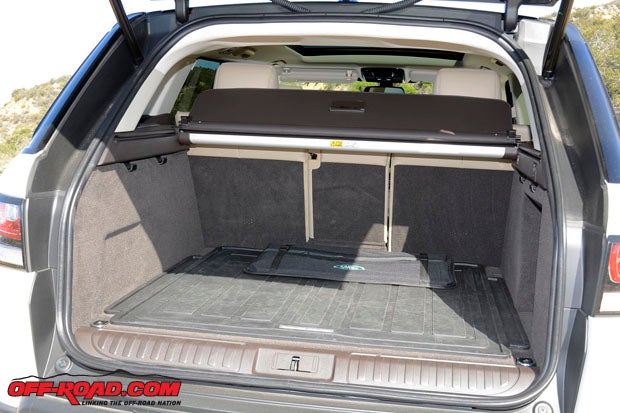
The Terrain Response 2 system featured on the Sport allows the driver to hand pick the proper suspension and handling setting for the vehicle depending upon the terrain. The system features six different settings, which include General, Dynamic, Grass/Gravel/Snow, Mud/Ruts, Sand and Rock Crawl. There’s also the option of using the Auto setting, which will allow the vehicle to automatically select whichever it mode it feels is most appropriate.
Working in concert with its air springs and Active Dynamics variable dampers, the Range Rover Sport also features Active-Roll Control (ARC) that replaces traditional anti-roll bars to reduce body roll thanks to actuators that rely on a hydraulic pump to constantly adapt to body changes up to 1,000 times a second. This new two-actuator system, which replaces the one-actuator version found on the first Sport model, offers more precise adjustment as it allows each axle to respond independently to lateral roll.
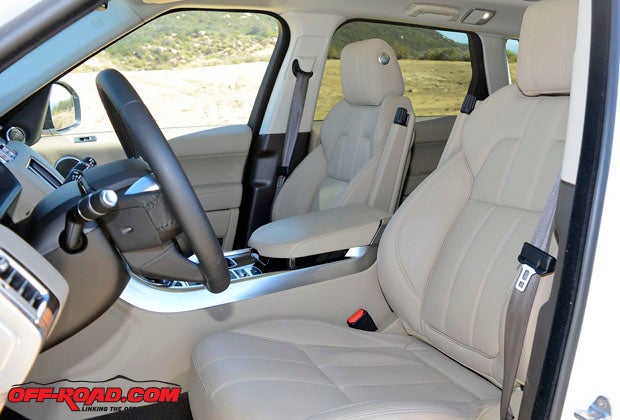
The Sport’s air suspension system thoughtfully provides the added lift to get the vehicle off the ground during off-road use, but Range Rover has always made a name for itself by its ability to find traction in just about any terrain. To aid in this effort, the SUV features a Dynamic Active Rear Locking Differential, which is essentially a limited-slip system that is electronically controlled to vary the degree of lock to aid in traction, handling and cornering stability as well. The Dynamic Active Rear Locking Differential also works in conjunction with the vehicle’s electronic torque vectoring system that uses braking to balance the distribution of torque among all four wheels.
Other off-road features on the Range Rover Sport include Hill Descent Control, which allows the driver to focus on steering as the vehicle maintains a safe downhill speed, and Gradient Release Control, which will aid in holding brake force during steep descents. Whether on road or off, the Hill Start Assist system will also comes in handy to keep the vehicle from rolling back while on steep uphill grades.
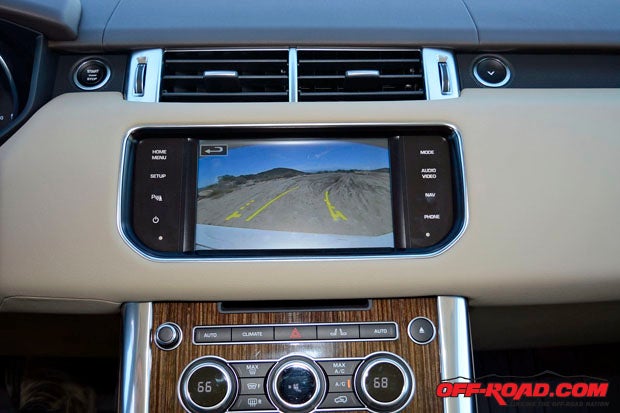
The inside of the Range Rover Sport exudes pure luxury. The soft touch dash accents the center-mounted 8-inch touchscreen that controls the stereo, navigation and phone functions. Woodgrain and brushed aluminum accents are featured throughout the interior, and overhead the sliding panoramic roof provides a view to the heavens for front and backseat passengers. Dual-zone climate controls allow for each front passenger to adjust the temperature, and both 14-Way Power Font Seats can be adjusted for that ideal angle (and saved via the seat memory function). The leather-wrapped steering wheel features power tilt and telescopic adjustment, and just in front of the driver the instrumentation features an analog speedometer and tachometer that surround a digital display that shows everything from tire air pressure to trip information.
Our upgraded Range Rover Sport was also equipped with heated and cooled front leather seats, the Rover Tow Package (which allows for a braked trailer rating of 7,716 lbs.), Meridian Premium audio, 22-inch Style 504 wheels and a host of other goodies.
Fancy a Stroll
During the time the Range Rover Sport was in our possession, one thing was abundantly clear: This vehicle is a head turner. Driving around town, we definitely caught a few glances every time we got behind the wheel. The plush feel of the leather interior and soft-touch dash and its wood and metal accents give the cabin a luxurious vibe. The look and feel aren’t simply window dressing however, as the cabin is just as comfortable for passengers as it is sexy. The massive panoramic sunroof is amazing, especially on warm and sunny days. The 60/40 split rear seat also made it easy to load and unload gear through the back – it may be pretty, but it still needs to function as an SUV. Oh yeah, and the push-button rear door closure is a nice touch.
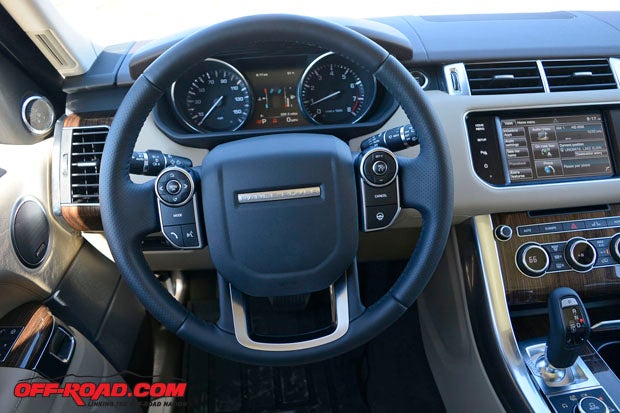
There’s a lot to love about the interior on the Range Rover Sport, but we are not the biggest fans of the touchscreen system. We found ourselves having to hunt around for the proper screen at times to switch to the appropriate audio setting or when looking for navigation. We certainly appreciate the easy-to-use dual climate control settings, and the steering wheel buttons make operating stereo, instrumentation functions and phone calls simple. The CommandShift shifter on the center console is easy to use, and the manual function works great and really gives the driver greater control of the engine when needed. The Terrain Response 2 system located just behind the shifter is also easy to use and is well designed for ease of use.
When driving around town, we found it hard not to lean into the throttle at times, as the supercharged V6 really seems to liven up in the midrange. It’s a fun car to drive once at speed. We were a little surprised it didn’t have a livelier bottom end, though, as its blower makes its peak torque in the middle of the engine’s rpm range (332 lb.-ft. @ 3,500-5,000). The Intelligent Start/Stop also took a little getting used to at stoplights, as the engine would shut off while the vehicle was stopped and not fire back to life until we took our foot off the brake. There’s a pause between the engine firing up and throttle response, which might account for the bottom end feeling less lively than we’d expect. We are happy to know the system can be turned off each time you enter the vehicle. We noticed a good amount of pedal travel as well, so the fly-by-wire throttle on our vehicle just might need some adjustment.
In terms of handling, the Range Rover Sport steers precisely during tight cornering and feels smooth in windy turns. It has a sporty feel with its handling that is nicely paired with the supercharged engine, and it feels most playful while at speed on windy country roads. We did notice a bit more body roll than expected in turns, and we were a little surprised with the amount of cabin noise (especially considering its road-friendly tires), but overall the on-road handling of the Sport gets the thumbs up for comfort and fun factor.
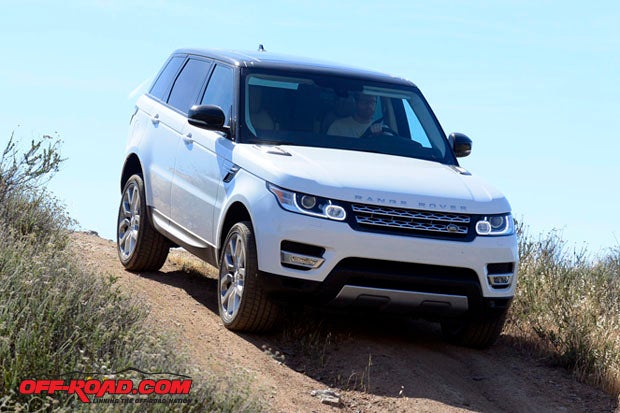
In spite of the long list of features and technological enhancements on the 2015 Range Rover Sport, we were still a bit nervous getting it into the dirt. We were initially worried about body clearance, but once we raised the vehicle to the highest off-road setting we felt more confident in the SUV’s abilities. We were also impressed that it will stay at the highest setting up to 33 mph, which makes traveling on bumpy dirt roads – about as extreme as many owners of this vehicle will get – very comfortable and trouble-free.
We found a steep downhill section during off-road testing and figured we should give it a go. So after shifting into low we crawled down the slope gently at first. Alas, no rubbing or catching at all. We backed up and tried it again, this time letting the Sport crawl down as we stayed off the brakes. We slightly rubbed the plastic under guard this go around (which is what it’s designed for), but overall the Sport took the challenge in stride.
Our next challenge was a climb up a soft, sandy hill. Range Rovers are known for their ability to find traction, and we noticed no signs of slipping on the hill section – it grabbed traction immediately and never lost that control. We continued on to an even steeper hill, this one being more hard-packed with light sand sprinkled across it. Here is where we found some limitation. Although the vehicle appeared to have the traction, the road-friendly Continental Cross Contact tires just couldn’t grip the surface and we were forced to back down the hill. Overall, we were impressed with the off-road prowess of this luxury SUV, though we were reminded there are limitations to what you’ll want to tackle.
When it comes to fuel economy, the supercharged 3.0-liter V6 is rated at 17 mpg in the city and 22 on the highway, with a 19 mpg combined rating. Our overall fuel consumption was a bit under that mark at 16.9 mpg, which could partially be our exuberance with the supercharged engine. In spite of our test number, we believe it’s realistic to expect somewhere in the 18-19 mpg range for overall consumption over a prolonged period.
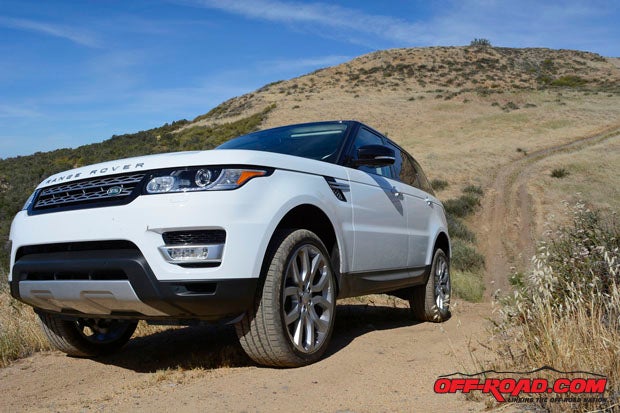
Final Thoughts
Although we weren’t sure exactly how to define the 2015 Range Rover Sport when we first received it, it’s clear that Range Rover does. Whereas some manufacturers will take an off-road-minded SUV and dress it up (see our recent Toyota 4Runner review), the Range Rover places its highest priority on luxury and performance, all the while paying homage to the off-road heritage on which the company was founded. That’s not to say that other manufacturers don’t place emphasis on these aspects, but Range Rover places those at the top. The company also heavily weighs the importance of technological advancements and features, having really pioneered the mass production of aluminum structures back in 2003.
There are areas that really wowed us with the Range Rover Sport, and there are areas we felt it could be improved, but overall we came away impressed that this opulent SUV didn’t disappoint when it left the pavement. With a price tag of $80,977 as tested, we’re still scared of its cost, but we can see how this vehicle is a great fit for those wanting solid off-road capability in a sporty package.
Specifications – 2015 Range Rover Sport V6 SC HSE
Engine: 90-degree 3.0L DOHC supercharged V6
Horsepower: 340 hp @ 6,500 rpm
Torque: 332 lb.-ft. @ 3,500-5,000 rpm
Transmission: ZF 8-speed electrically controlled automatic
Height: 70.1 in. (68.1 in. Access Mode, 72.6 in. Off-Road Mode)
Track Width: 66.5 in. (front), 66.3 in. (rear)
Length: 191 in.
Wheelbase: 115.1 in.
Approach Angle: 33 degrees (off-road height)
Departure Angle: 31 degrees (off-road height)
Breakover Angle: 27 degrees (off-road height)
Ground Clearance: 10.9 in.(off-road height)
Claimed Curb Weight: 4,727 lbs.
Gross Vehicle Weight Rating: 6,504 lbs.
Towing Capacity: 7,716 lbs. (braked trailer), 1,653 lbs. (unbaked trailer)
Payload Capacity: N/A
Fuel Tank: 27.7 gal.
Seating Capacity: 5 (as tested (7 w/third-row seating)
Axle Ratio: N/A
Aver. MPG (tested): 16.9 mpg overall
Price: $80,977*
*Sticker price as tested, includes destination charges


 Your Privacy Choices
Your Privacy Choices